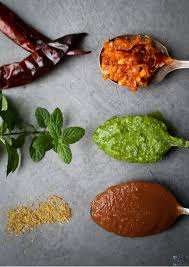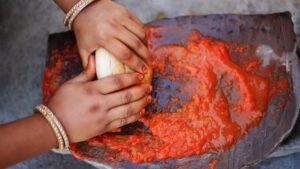Chutneys have been an integral part of Indian cuisine for centuries, offering a burst of flavors that perfectly complement traditional meals. From sweet to tangy, spicy to savory, the best desi chutney in India varies based on the region and the ingredients used. In this blog, we’ll explore what makes chutneys so unique and introduce you to some of the most beloved varieties.
Table of Contents
What Makes the Best Desi Chutney in India Special?
The charm of the best desi chutney in India lies in its diversity. Indian chutneys are made from fresh herbs, spices, fruits, and vegetables, giving them a wide range of flavors. What sets them apart is the balance of flavors – a perfect combination of sweet, sour, spicy, and sometimes even bitter. They’re also often made using traditional methods, which can enhance the taste and texture, adding a layer of authenticity to the chutney.
Popular Types of Desi Chutney Across India
Mint Chutney: A Refreshing Delight
One of the most popular chutneys in India, mint chutney offers a fresh, cooling effect. Made with mint leaves, green chilies, and a variety of spices, it’s commonly served with snacks like samosas, pakoras, and even grilled meats. The best desi chutney in India can often be found at street food stalls, providing a refreshing complement to spiced foods.
Coriander Chutney: A Flavorful Companion
Coriander chutney is known for its zesty and tangy flavor. Made with fresh coriander leaves, green chilies, garlic, and lemon juice, this chutney is a staple in many Indian households. It’s often paired with parathas, dosas, or even sandwiches, making it a versatile condiment and one of the best desi chutney in India.
Tamarind Chutney: Sweet and Sour Perfection
Tamarind chutney is a favorite in North India, thanks to its sweet, sour, and spicy profile. Made from tamarind pulp, jaggery, and spices, it’s a classic accompaniment to chaats and fried snacks. The best desi chutney in India made from tamarind brings the perfect balance of flavors, adding richness to any meal.
Mango Chutney: A Seasonal Favorite
Mango chutney is especially popular during the mango season. Made from ripe or raw mangoes, sugar, vinegar, and spices, it offers a sweet and tangy taste that complements meats, rice, and even parathas. This chutney is often considered one of the best desi chutney in India for its unique fruity flavor.
Peanut Chutney: Nutty and Rich
In South India, peanut chutney is a go-to condiment. Made with roasted peanuts, green chilies, garlic, and tamarind, it has a rich, nutty flavor that goes perfectly with idlis, dosa, or uttapams. Its creamy texture and rich taste make it one of the best desi chutney in India, especially for breakfast dishes.
Ingredients that Define the Best Desi Chutney in India
The best chutneys in India often feature fresh ingredients like herbs, spices, and fruits, which define their unique flavor profiles. For example, mint, coriander, and tamarind are key ingredients in many chutneys, each adding a distinct flavor. The best desi chutney in India often involves a careful balance of these ingredients, with the use of traditional methods (like stone grinding) to bring out their full potential.
How to Make the Best Desi Chutney in India at Home
Making chutney at home ensures that you get the freshest flavors. Here’s how you can prepare a classic mint chutney:
- Blend together fresh mint leaves, green chilies, ginger, garlic, and lemon juice.
- Add a pinch of salt and a little water to achieve the desired consistency.
- Serve immediately with your favorite snacks like samosas, pakoras, or even rice.
The traditional stone grinder (silbatta) can add an extra layer of flavor, as it helps release the essential oils from the herbs, making the chutney even more aromatic.
Why the Best Desi Chutney in India Is Made Fresh
Fresh chutney is not only more flavorful, but it’s also healthier. The World’s Best Chutney uses all-natural, fresh ingredients, without preservatives or added sugars. It’s also packed with nutrients from herbs like mint and coriander, which are known for their digestive and immune-boosting properties. Homemade chutney also retains more nutrients than store-bought versions, making it the healthier option.
Serving Suggestions: Pairing the Best Desi Chutney in India
The best desi chutney in India can be paired with nearly every type of Indian meal:
- Serve mint chutney with samosas, pakoras, or parathas for a cool, refreshing contrast.
- Tamarind chutney is perfect with chaats, bhel puri, or even rice.
- Peanut chutney can be paired with idli, dosa, or uttapam for a rich, creamy addition to your breakfast.
These chutneys can turn a simple meal into an extraordinary one by complementing the primary dish and adding complexity to the flavors.
The Health Benefits of the Best Desi Chutney in India
Chutneys made from fresh herbs like mint and coriander offer numerous health benefits. Mint is known for its cooling properties and aids digestion, while coriander helps with detoxification. Tamarind chutney is also rich in antioxidants. The best desi chutney in India is a healthier alternative to heavy gravies and sauces, offering a burst of flavor without excess calories or preservatives.
Conclusion: Why the Best Desi Chutney in India Is a Must-Have on Every Indian Table
The best desi chutney in India is an essential part of Indian cuisine. Whether it’s a tangy tamarind chutney, a refreshing mint chutney, or a rich peanut chutney, these chutneys can elevate any dish, from snacks to main courses. By making chutney at home, you can enjoy the freshest, healthiest, and most flavorful version of this traditional condiment. So go ahead and try making your favorite chutney at home!
Follow us on social media platform :- Instagram and Facebook
FAQs
1. What makes the best desi chutney in India stand out from others?
The best desi chutney in India stands out due to its freshness, balance of flavors, and the use of high-quality, locally-sourced ingredients like fresh herbs, spices, and fruits.
2. How can I store homemade chutney?
Homemade chutneys can be stored in an airtight container in the refrigerator for up to 2-3 days. Some chutneys, like tamarind chutney, can even be preserved for longer periods.
3. Which chutney is most popular in India?
Mint chutney, coriander chutney, and tamarind chutney are some of the most popular chutneys in India, often served as accompaniments to snacks and main dishes.
4. Can chutney be made without sugar or preservatives?
Yes, chutneys can easily be made without sugar or preservatives by using natural sweeteners like jaggery or fruits and fresh ingredients.





